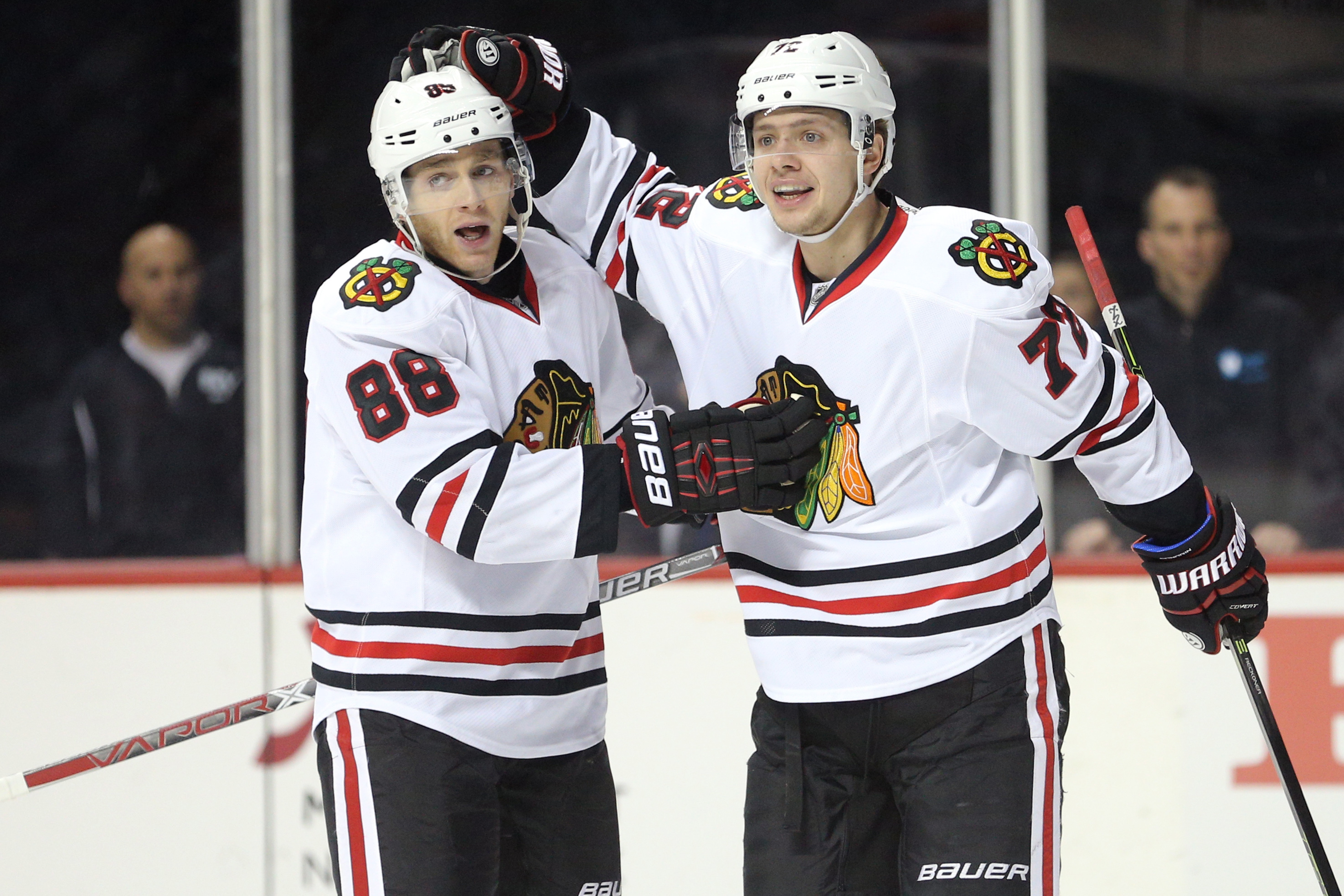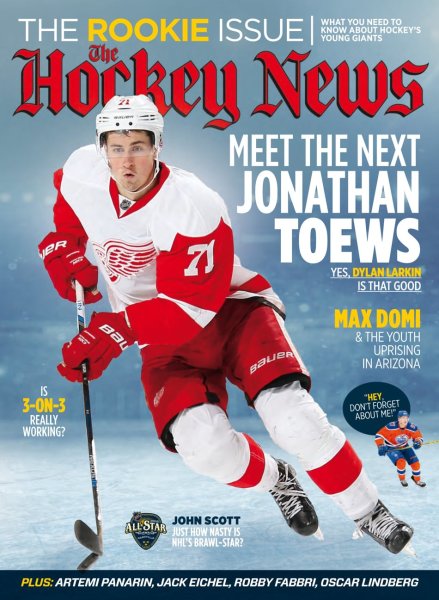
From the THN Archives: How Artemi Panarin broke out in the KHL before he took off alongside Patrick Kane in Chicago.
From the THN Archives: How Artemi Panarin broke out in the KHL before he took off alongside Patrick Kane in Chicago.

For a couple seasons, it seemed like the Empire had only gotten stronger.
Like when Romans built Constantinople, or Emperor Palpatine got the better of Anakin Skywalker, or the New York Yankees drafted Aaron Judge, the dominant Chicago Blackhawks only got better when they won the Artemi Panarin sweepstakes in 2015. Signing a breakout KHL scorer, Chicago only got stronger on the heels of its third Stanley Cup in six years — not quite a dynasty by standard definitions, but who the hell’s gatekeeping that, anyhow?
For such a recent memory in the NHL, Artemi Panarin's rookie year deserves a review. At 24, he became the oldest player to win the Calder Trophy since Evgeni Nabakov at 25 in 2001 — to the chagrin of some pundits. On a line with Patrick Kane and Artem Anisimov, Panarin put up 30 goals and 77 points as a rookie, setting the table for a long career with Chicago.
That never came.
Age and bloated contracts got the better of Chicago, and the empire fell. After his sophomore season saw the Western Conference-leading Hawks swept in the first round by Nashville, Panarin got shipped off to Columbus so Chicago could get back power forward Brandon Saad. The retooling moves didn't work, though, and Chicago has made the playoffs in just one of the past seven seasons (thanks to the pandemic-spawned play-in round, no less).
After failures piled up, the empire's remnants stick out like ruins across the league. Patrick Kane was a Ranger and is now a Red Wing. Duncan Keith and Brent Seabrook are out of the league. For all intents and purposes, Jonathan Toews seems done too, barring a major comeback. Meanwhile, Panarin is lighting it up for the New York Rangers as they chase a President's Trophy this season, alongside fellow KHL import Igor Shesterkin in net.
Chicago's fall was bound to happen, but how quickly it occurred shows how much can change year to year in the NHL. One day, a team like the Hawks bullies a conference. The next, it could wind up a bottom-feeder. In a league with so much parity alongside so much worldwide talent, dynasties can rise and fall with a quickness.
Today, we reach back into the Archive to Panarin's rookie year, the same when Detroit captain Dylan Larkin was but a young lad himself and Robby Fabbri carried hopes and dreams for St. Louis, too. Back then, the Kane-Panarin duo was poised to set the league on fire. Now, they will face each other with the Rangers and Red Wings this Wednesday night in Detroit.
Here's an archive gem on Panarin's breakout KHL season and how that set the table for Panarin's Calder-winning year.
From the THN Archive: "Packing a Punch: Artemi Panarin has gone from KHL obscurity to first-line minutes in Chicago" by Dan Marrazza.
Feb. 15, 2016 / Volume 69, Issue 12

WHEN THE 2012-13 lockout ended, the effects went way beyond the NHL, NHLPA, players and fans. They were felt as far away as Russia, where Artemi Panarin was languishing in anonymity on HC Chekhov Vityaz, the KHL’s version of the Bad News Bears
Chekhov’s leading scorer during a good portion of Panarin’s four seasons with the team was ex-NHL enforcer Chris Simon. One of his coaches was former NHL goon Andrei Nazarov, whose KHL coaching career has been marked by a series of ugly incidents, including when he attacked an opposing team’s fans with a stick and hospitalized his team’s doctor following a physical altercation in the dressing room. Panarin never had more than 12 goals in any season while playing for Chekhov, based in the Russian industrial city of Podolsk. He bounced back and forth between his team’s top scoring lines and its bottom six, as Chekhov finished at or near the bottom of its conference four straight years.
Soon after the lockout ended, however, Panarin went from the outhouse to penthouse when he was dealt to St. Petersburg SKA after the KHL extended its trade deadline because of the exodus of players back to the NHL. St. Petersburg had lost its two biggest offensive stars in Ilya Kovalchuk and Vladimir Tarasenko after they were returned to their NHL teams and were in desperate need of adding some scoring.
For Panarin, the trade was a turning point in his career. He helped St. Petersburg to the conference final before losing to eventual KHL champion Moscow Dynamo. The next season, Kovalchuk left the NHL and returned to St. Petersburg – and that’s when Panarin’s game really took off. Playing with Kovalchuk was the trigger that turned Panarin from a virtual unknown on both sides of the Atlantic into one of the KHL’s elite scorers – and now into one the NHL’s hottest rookies. “Even in Russia, I wasn’t really known when I was 18,” he said. “Then I got to the right place. Ilya Kovalchuk was there. I was watching him, and I grew my game because of that.”
Viktor Tikhonov was teammates with Panarin for two years in St. Petersburg and most recently with the Chicago Blackhawks, before being claimed off waivers by the Arizona Coyotes in early December. He witnessed the change in Panarin after the trade, first as an opponent and then as a teammate. “To be honest, I don’t remember noticing him playing against him with Chekhov,” Tikhonov said. “I remember that team having a lot of big guys, and they used to like to fight a lot. They were a team where if they don’t have a fight, but the team wins, the fans go home disappointed. If the team is losing, but there’s a fight, they’ll be clapping…In Chekhov, they had guys practicing with punching bags, and that’s what he was learning. That’s not his game. He has a ton of talent.”
Panarin had hardly played in a big game or with elite linemates until his trade to St. Petersburg. There he got to play a classier brand of hockey alongside the likes of Kovalchuk, Tikhonov and Roman Cervenka. And Panarin flourished, nearly doubling his previous career high in his first full season in St. Petersburg, with 20 goals and 40 points to tie Kovalchuk for the team lead in scoring. Last season, he finished with 62 points in 54 games, usurping his mentor as St. Petersburg’s scoring leader and leading his team to a KHL championship. “(Kovalchuk) told me all about the NHL,” Panarin said. “He told me to be myself, play my game and don’t lose my confidence. He told me to play like I know how to play.”
As much as Panarin proved his mettle in the KHL, success in Russia doesn’t necessarily translate to the NHL. There are countless examples of high scorers who have excelled in the KHL, only to see their production dwindle when faced with the tighter checking and smaller ice surfaces in the NHL.
In fact, when Panarin arrived in North America before this season, he was one of three marquee free agent scorers to arrive in the NHL via the KHL. And he’s the only one to have made a successful transition. Sergei Plotnikov, a 25-year-old winger who starred for Lokomotiv Yaroslavl last season, had zero goals and only two assists in his first 30 games with the Pittsburgh Penguins. Steve Moses, an undersized American-born winger who set a KHL record by scoring 36 goals with Jokerit (Helsinki) last season, signed with the Nashville Predators and didn’t even make the team in training camp. He continued to struggle with the AHL’s Milwaukee Admirals and has since returned to the KHL after scoring only twice in 17 minor league games in North America.
Panarin, meanwhile, has nearly been a point-per-game player in the NHL. The Blackhawks, who he chose from a long list of suitors, have eased his transition. He's been given a chance to play on a line with Patrick Kane and centered by countryman Artem Anisimov. He found instant chemistry with Kane, who at 5-foot-11 and 175 pounds is almost the same size as Panarin and plays a similar, smooth-skating, puck possession style. “We’re on the same wavelength,” Panarin said. “He understands me, even when I don’t speak English.”
That chemistry between the two has carried the Blackhawks’ offense through the first half of the season. With the exception of Kane and Panarin, most of Chicago’s forwards were having subpar individual campaigns. At the season’s midway point, Jonathan Toews was on pace to finish with fewer than 50 points for the first time (in a non-lockout season). Marian Hossa could finish with fewer than 40. This is all occurring as neither Teuvo Teravainen nor Andrew Shaw have developed their offensive games as expected, and the Hawks never quite finding a power forward to replace Brandon Saad.
And there is cause for concern that the production from Chicago’s newest dynamic duo might drop off. Coming into this season, Kane’s points-per-game average for October, November and December was 1.12. For January, February, March and April, it was 0.88. While Panarin has yet to experience the full grind of an NHL season – KHL seasons are 60 games long – and will soon enter unchartered territory. But Kane isn't worried. “The way we want to play is similar,” Kane said. “The more he gets experience and the more he gets confidence, his game is only going to grow. He has a bright future.
The THN Archive is an exclusive vault of 2,640 issues and more than 156,000 stories for subscribers, chronicling the complete history of The Hockey News from 1947 until today. Visit THN.com/archive and subscribe today at subscribe.thehockeynews.com
Also from THN Detroit
THN Mailbag: Retaining Patrick Kane, Prospect Musings and the Future of the Goalie Room
Snapping 10-start Losing Streak, Alex Lyon Comes up Clutch Against Lightning
Perron Plays Hero as Red Wings Persevere for 4-2 Win in Tampa and Two Vital Points
Augustine, MSU See Triumphant Season End One Win Shy of Frozen Four
